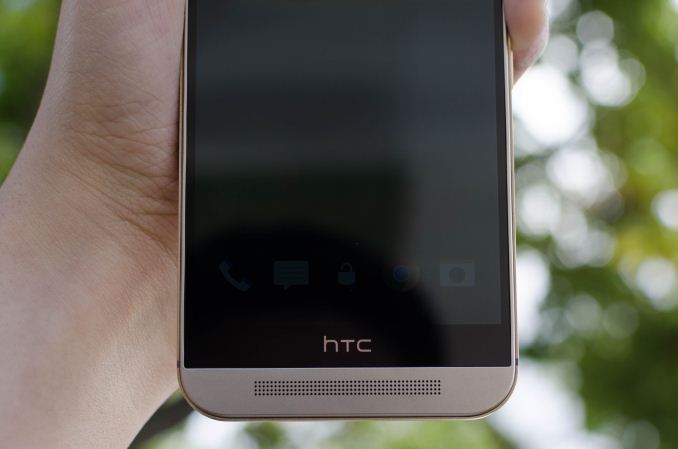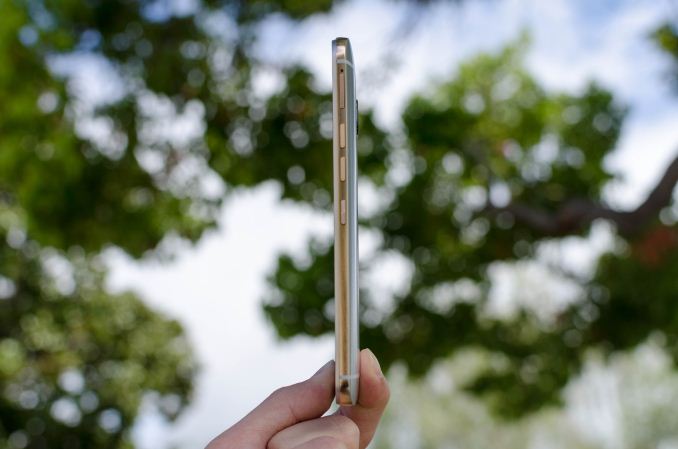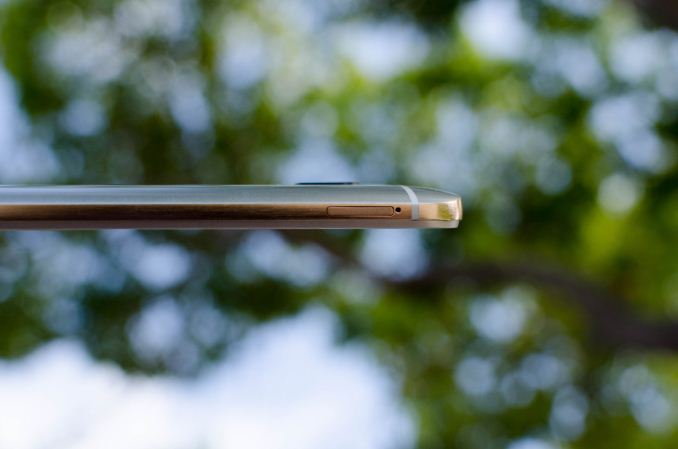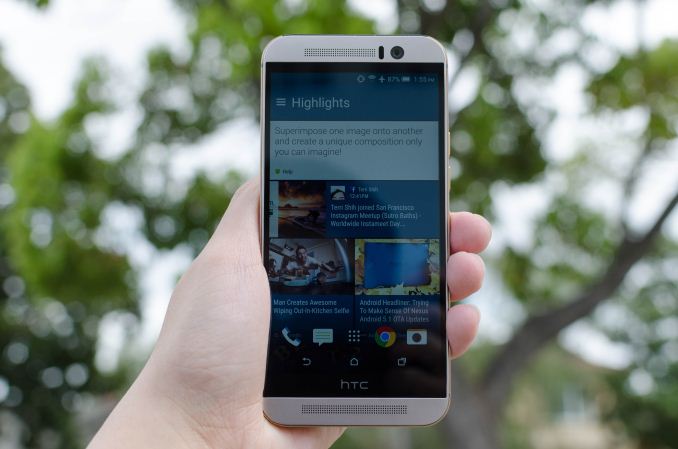The HTC One M9 Review: Part 2
by Joshua Ho on April 6, 2015 10:00 AM EST- Posted in
- Smartphones
- HTC
- Qualcomm
- Mobile
- Snapdragon 810
- One M9
Final Words
Now that we finally have all of the pieces together, we can come to some proper conclusions about the HTC One M9. For those that haven’t read part one of this review, it’s really necessary to do so to understand the context in which these comments are made.
There’s a lot to talk about here, so we’ll start with the design of the phone. HTC is probably the company best-known for design in the Android space, and with the One M9 it seems that they hope to capitalize on this by electing not to significantly change the design.
However, there are a few key changes to the One M9’s design when comparing it to the One M8. For instance, the One M9 moves the power button to the right side of the phone, changes the finish of the back cover, squares off the back cover, and replaces the front plastic bezel with a new plastic bezel. All of these changes seem to make some sort of sense at first, but they almost feel like a regression in some ways. The power button is on the side, but it takes a lot of effort to press it when the phone is held normally in the hand. However, it’s conveniently placed to accidentally press when picking the phone up from a table.
Meanwhile the back cover has a new finish and a neat dual-anodized color, but I question the value of these changes when they reduce yield and drive cost up, especially when sand-blasted anodized aluminum is comparable in look and feel. The continued use of the plastic bezel on the front also cheapens the feel of the phone. The new hard edges on the back cover is also quite uncomfortable, especially when compared to the M8’s smoother curve. There is also the issue of the “logo bar” bezel, but it’s physically impossible to get rid of this bezel due to engineering constraints.
The next aspect worth examining is the display. To HTC’s credit, a 1080p display at 5 inches is the right tradeoff to make with an RGB-stripe display. However, it’s concerning to see significant regressions in almost every area when comparing the display to the M8. An amazing display is almost a requirement for flagship smartphones at this point, and to see such a poor display with equally poor calibration is disappointing. It was clear in the past that HTC genuinely cared about delivering an amazing display, but somewhere along the way it seems that they forgot. We can speculate about the reasons behind this, but this is something that HTC has to fix if they want to remain relevant in the smartphone space, just like every other OEM at this point.
The other critical point of a smartphone is its ability to remain mobile. Battery life is probably the most important aspect of any smartphone, and a poor showing here can be enough to write off a phone. HTC has traditionally done quite well here despite using a smaller battery in their phones than average. Unfortunately, this isn’t true of the One M9. Despite using a newer SoC and a bigger battery, HTC regresses significantly in battery life when compared to the One M8. Although it seems that MIPI command mode has been removed from the One M9, it’s likely that most of the increased power draw can be directly attributed to the SoC, as the impact of panel self-refresh is relatively small.
Speaking of the SoC, the Snapdragon 810’s performance does generally provide a decent improvement over the Snapdragon 805, but it’s relatively little due to HTC’s governor settings which make it quite difficult to reach the maximum 2 GHz state. GPU performance is better than what we see on the Galaxy S6, but this is due to HTC’s choice to stay at a lower native resolution. At the same resolution, the Exynos 7420’s Mali T760 GPU is faster due to higher clock speeds. It’s also disappointing that HTC continues to use benchmark optimizations. The difference in performance is so small at this point that HTC should seriously consider removing these optimizations altogether, as it isn’t worth getting delisted from multiple benchmarks.
The camera of the One M9 is also a weak point, despite significant changes on HTC’s part in this area. Unfortunately, the post-processing here is just not acceptable, and the results of the camera are equally unacceptable. We will have to see how the camera performs without HTC’s heavy-handed post-processing when they update the camera to shoot in RAW, but HTC needs to improve dramatically here for next year.
The one positive note here is Sense 7, which continues to be one of the best experiences in Android overall. I fundamentally disagree with the assertion that a user should go to the Play Store to find various applications that they like, as taking this to its logical conclusion basically ends with having to download a dialer application from the Play Store on first boot. Blinkfeed continues to be a solid application for news, social media, and other information, and HTC’s apps in general are a strong point of differentiation judging by the demand from users to port them to non-HTC phones. However, I still think that HTC didn’t do enough for this iteration of Sense. Most of the applications still feel like they mesh best with Android 4.4, and overall the UI needs to be redesigned to fit with Material Design.
Overall, further testing of the One M9 basically confirms my fears, which were that the One M9 is effectively a sidegrade of the One M8 at best. I really did want to like this phone, as I still find the One M7 to be a great phone to use. I really wanted to see a phone from HTC that was worthy of an upgrade from the One M7, but the One M9 isn’t that phone. In fact, given that the One M8 is at least 200 dollars cheaper than the One M9 on contract, I find it incredibly difficult to recommend the One M9. It will definitely have its fans, but overall there are more negatives than positives. Given the competitive positioning of the One M9, the timing of the Snapdragon 810, and the strength of the Galaxy S6 I’m faced with an intense sense of déjà vu. It almost feels like we’re back where we started 3 years ago with the Sensation and Galaxy S2. I can't think of a better way to describe the situation HTC is in, which is alarming to say the least. The One M9 can't be another Sensation, but it feels like it is.














127 Comments
View All Comments
TrojMacReady - Tuesday, April 7, 2015 - link
Colors were more accurate, resolution a hair higher, contrast and blacklevels were seriously lagging compared to the S2, speed of the phone was quite a bit slower, camera was much worse too.CrazyElf - Monday, April 6, 2015 - link
Thanks for the review.It's a disappointing phone. I wonder what they were thinking about when they made this? Hmm, probably not much on how it would be received.
zodiacfml - Monday, April 6, 2015 - link
Heartbreaking even without the S6. The S6 is just too good right now.mhaager2 - Monday, April 6, 2015 - link
Joshua, your concerns regarding the snapdragon 810, do you think they are device specific or can we expect this to hold true across different flagship phones? I'm waiting for the Xperia Z4 but wondering if it's worth it compared to the 801 in the Z3kspirit - Tuesday, April 7, 2015 - link
I hope the Z4 and G4 both use the S808 or even 805 instead of this (literally) hot mess.lilmoe - Monday, April 6, 2015 - link
Ouch. That horrible SoC might have been OK to swallow, but the camera is definitely a deal breaker for many...They could have stuck with the exact same design and internals of the M8 while dramatically improving the camera, and it would have been much more of an upgrade than ^this...
On a side note, HTC SERIOUSLY needs to reconsider the internal design and layout of components. Repairing the One, _any One_, is a nightmare.
Gunbuster - Monday, April 6, 2015 - link
Repair has been a nightmare since always for HTC, Touch Pro's and Radar come to mind.Dorek - Wednesday, April 8, 2015 - link
I was going to replace my Radar's battery before I decided to just buy a new phone, and it didn't look too awful...Gunbuster - Thursday, April 9, 2015 - link
Battery is okay, anything involving the screen stack that is glued to the digitizer...Also super easy to wreck the microphone mylar flex cable.
tom5 - Monday, April 6, 2015 - link
So to wrap-up: HTC had quite a nice device to start with - the HTC One M8, but decided to ruin it all, starting with the camera subsystem which is a joke, followed by a I'm_A_Mistake_SoC - the 810. Samsung knew what they were doing when they chose their own Exynos to power the S6.It's a pity because I really like HTC devices. Having put so much emphasis on the camera features I just can't believe what they did in this area with the M9. They wanted to "buy" us with the megapixel count or what?